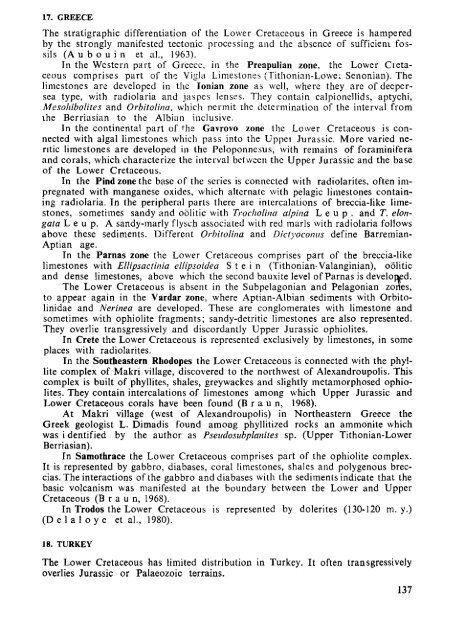THE MEDITERRANEAN LOWER CRETACEOUS
THE MEDITERRANEAN LOWER CRETACEOUS
THE MEDITERRANEAN LOWER CRETACEOUS
You also want an ePaper? Increase the reach of your titles
YUMPU automatically turns print PDFs into web optimized ePapers that Google loves.
17. GREECE<br />
The stratigraphie differentiation of the Lower Cretaceous in Greece is hampered<br />
by the strongly manifested tectonic processing and the absence of sufficient fossils<br />
(A u b о u i n et al., 1963).<br />
In the Western part of Greece, in the Preapulian zone, the Lower Cretaceous<br />
comprises part of the Vigla Limestones (Tithonian-Lowe: Senonian). The<br />
limestones are developed in the Ionian zone as well, where they are of deepersea<br />
type, with radiolaria and jaspes lenses. They contain calpionellids, aptychi,<br />
Mesohibotites and Orbitolina, which permit the determination of the interval from<br />
the Berriasian to the Albian inclusive.<br />
In the continental part of the Gavrovo zone the Lower Cretaceous is connected<br />
with algal limestones which pass into the Uppei Jurassic. More varied neritic<br />
limestones are developed in the Peloponnesus, with remains of foraminifera<br />
and corals, which characterize the interval between the Upper Jurassic and the base<br />
of the Lower Cretaceous.<br />
In the Pind zone the base of the series is connected with radiolarites, often impregnated<br />
with manganese oxides, which alternate with pelagic limestones containing<br />
radiolaria. In the peripheral parts there are intercalations of breccia-like limestones,<br />
sometimes sandy and oolitic with Trocholina alpina L e u p . and T. elongata<br />
L e u p. A sandy-marly flysch associated with red marls svith radiolaria follows<br />
above these sediments. Different Orbitolina and Dictyoconus define Barremian-<br />
Aptian age.<br />
In the Parnas zone the Lower Cretaceous comprises part of the breccia-like<br />
limestones with Ellipsactinia ellipsoidea Stein (Tithonian-Valanginian), oolitic<br />
and dense limestones, above which the second bauxite level of Parnas is developed.<br />
The Lower Cretaceous is absent in the Subpelagonian and Pelagonian zones,<br />
to appear again in the Vardar zone, where Aptian-Albian sediments with Orbitolinidae<br />
and Nerinea are developed. These are conglomerates with limestone and<br />
sometimes with ophiolite fragments; sandy-detritic limestones are also represented.<br />
They overlie transgressively and discordantly Upper Jurassic ophiolites.<br />
In Crete the Lower Cretaceous is represented exclusively by limestones, in some<br />
places with radiolarites.<br />
In the Southeastern Rhodopes the Lower Cretaceous is connected with the phyllite<br />
complex of Makri village, discovered to the northwest of Alexandroupolis. This<br />
complex is built of phyllites, shales, greywackes and slightly metamorphosed ophiolites.<br />
They contain intercalations of limestones among which Upper Jurassic and<br />
Lower Cretaceous corals have been found (B r a u n, 1968).<br />
At Makri village (west of Alexandroupolis) in Northeastern Greece the<br />
Greek geologist L. Dimadis found among phyllitized rocks an ammonite which<br />
was i dentified by the author as Pseudosubplanites sp. (Upper Tithonian-Lower<br />
Berriasian).<br />
In Samothrace the Lower Cretaceous comprises part of the ophiolite complex.<br />
It is represented by gabbro, diabases, coral limestones, shales and polygenous breccias.<br />
The interactions of the gabbro and diabases with the sediments indicate that the<br />
basic volcanism was manifested at the boundary between the Lower and Upper<br />
Cretaceous (B r a u n, 1968).<br />
In Trodos the Lower Cretaceous is represented by dolerites (130-120 m. y.)<br />
(D e 1 a 1 о у с et al., 1980).<br />
18. TURKEY<br />
The Lower Cretaceous has limited distribution in Turkey. It often transgressively<br />
overlies Jurassic or Palaeozoic terrains.<br />
137

















